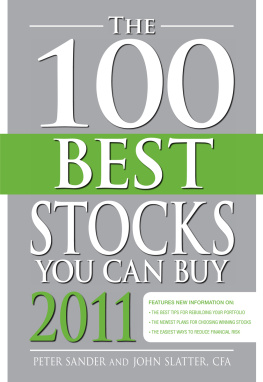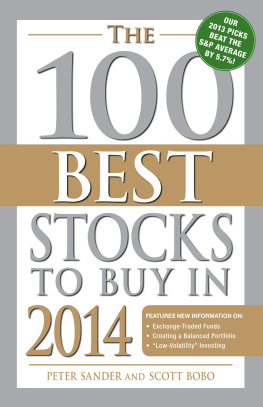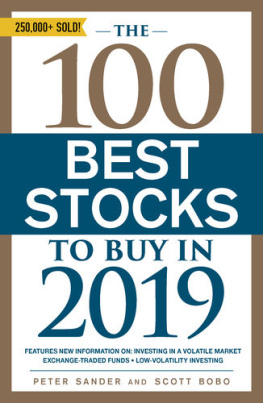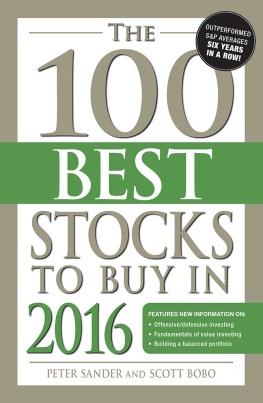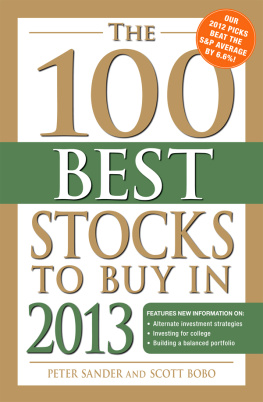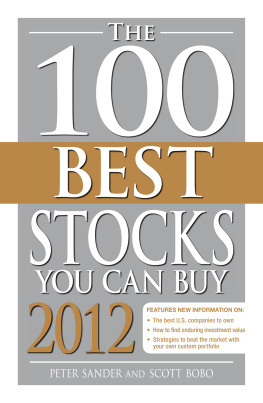THE
BEST
STOCKS
YOU CAN BUY
2011
PETER SANDER
AND
JOHN SLATTER, CFA

Copyright 2010 by F+W Media, Inc.
All rights reserved.
This book, or parts thereof, may not be reproduced in any
form without permission from the publisher; exceptions are
made for brief excerpts used in published reviews.
Published by
Adams Media, a division of F+W Media, Inc.
57 Littlefield Street, Avon, MA 02322. U.S.A.
www.adamsmedia.com
ISBN 10: 1-4405-0052-5
ISBN 13: 978-1-4405-0052-7
eISBN 10: 1-4405-0890-9
eISBN 13: 978-1-4405-0890-5
Printed in the United States of America.
10 9 8 7 6 5 4 3 2 1
Library of Congress Cataloging-in-Publication Data
is available from the publisher.
This publication is designed to provide accurate and authoritative information with regard to the subject matter covered. It is sold with the understanding that the publisher is not engaged in rendering legal, accounting, or other professional advice. If legal advice or other expert assistance is required, the services of a competent professional person should be sought.
From a Declaration of Principles jointly adopted by a Committee of the
American Bar Association and a Committee of Publishers and Associations
Many of the designations used by manufacturers and sellers to distinguish their product are claimed as trademarks. Where those designations appear in this book and Adams Media was aware of a trademark claim, the designations have been printed with initial capital letters.
This book is available at quantity discounts for bulk purchases.
For information, please call 1-800-289-0963.
Contents
Dedication
I continue to dedicate this book to all of you active investors who have the sense of purpose and independence of thought to make your own investing decisions, or at least, to ask the right questions. You continue to be wise enough and inquisitive enough to realize that not all the answers can be found in one place, and smart enough to seek the convenience of a good place to start.
Acknowledgments
Two pairs of eyes are better than one, and so for this 2011 edition I must once again thank my research partner and long time friend and colleague J. Scott Bobo for his prescient analysis and hard work. I must also recognize the good work of Value Line Inc. and their investment survey, which does more than any other investment service I know of to turn piles of facts and figures into a simple readable page. Next, no book happens without the added value of exercise to keep my body in shape and my mind clear, and to that end I offer my thanks to my exercise companions. And of course I must thank my family wife Jennifer and sons Julian and Jonathan for taking care of business while I engaged in this enterprise.
PART I
THE ART AND SCIENCEOF INVESTING IN STOCKS
By Peter Sander
The Art and Science of Investingin Stocks
Peter Sander
Congratulations on your purchase of the 2011 edition of The 100 Best StocksYou Can Buy.
If you bought this book, youre probably an astute and experienced individual investor who invests in individual stocks in individual compa-nies. Now, that might not seem so profound, but with the some 10,000 mutual funds, 8,000 hedge funds and countless Exchange Traded Funds (ETFs) and index funds out there, its not inconceivable that the individual stock investor is becoming an endangered species.
But thats just not so. For the better, not only for your own wealth but for the efficient allocation of capital to businesses and ideas that work best, millions still engage in this sort of pure investing for all or part of their wealth.
Even if you buy just a few shares of one company, youre an individual investor. Youre participating actively in the economy, and youre buying your share of the company with hopes of participating in its success. Like a homeowner choosing to take part in the work of owning a home as a do-it-yourselfer youre participating in the individual satisfaction, responsibility, and control that comes with doing it yourself.
If you succeed, you accept the benefits of increased wealth (and reduced fees) along with the satisfaction and sense of accomplishment of doing it yourself. If you fail, true, youll have no one else to blame but yourself. But at least you wont be forced to drink the poison of having someone else lose your money for you. In the entrepreneurial spirit that so characterizes America and much of the Western world, youll pick yourself up, dust yourself off, learn from the mistakes, and go out and do it again.
Every edition of The 100 Best Stocks You Can Buy, this 2011 edition included, is intended to be a core tool for the individual investor. Sure, its hardly the only tool available. Todays explosion of Internet-based investing tools has made this book one of hundreds of choices for acquiring investing information. With the speed of cyberspace, our book will hardly be the most current source. So instead, it is intended as a handy guide and core reference for your investing; not as a be-all end-all investing source. Thus, as much as a source of facts and numbers itself, 100 Best Stocks is intended as a model for selecting the best companies and stocks to invest in.
To that same point, 100 Best Stocks goes well beyond just being a stock screen or a study of stocks to invest in. Analysis forms the base of 100 BestStocks, but it isnt the rigid, strictly numbers-based selection and analysis so often found in published best stocks list. Sure, we look at earnings, cash flow, balance sheet strength and so forth, but well also look far beyond those things. Well look at the intangible and often subtle factors that make truly great businesses that is, companies great.
Great companies have good business fundamentals, but what makes them really great is the presence of intangibles and subtleties that will keep them great or make them greater in the future.
So the selection of the 100 Best Stocks continues to go far beyond being a simple numbers-based stock screen. Its a selection and analysis of really good businesses you would want to buy and own, not just for past results but for future outcomes. Now, does future mean forever? No, not hardly, not any more. Nothing is really forever these days as those who invested in GM or Eastman Kodak or AIG or Bank of America can attest. So while the 100 Best Stocks list correlates well with the notion of blue chip stocks, the discussion proceeds with the harsh reality that blue chip no longer means forever.
As the book title suggests, I feel that the 100 companies listed and analyzed in the pages that follow are the best companies to own for 2011. That said, the word own has become a more active concept these days. Gone are the days of own forever, like the halcyon days where my parents Jerry and Betty Sander, who bought their thirty-five shares of General Motors and lovingly placed the stock certificate in their safe deposit box and henceforth bought nothing but GM cars. Today, there is no forever; the economy, technology and consumer tastes simply change too fast, and the businesses that participate in the economy by necessity change with it. Ownership is a more active concept than it was even ten or twenty years ago.
So going forward, I offer the 100 best companies to own now and in 2011, and that have the best chances of not only surviving but evolving with or even ahead of the economy based on their current market position and approach to doing business. But as we all found out during the past two years, nothing is sacred in the business world and can fall apart with astounding speed. What does that mean?
Next page
